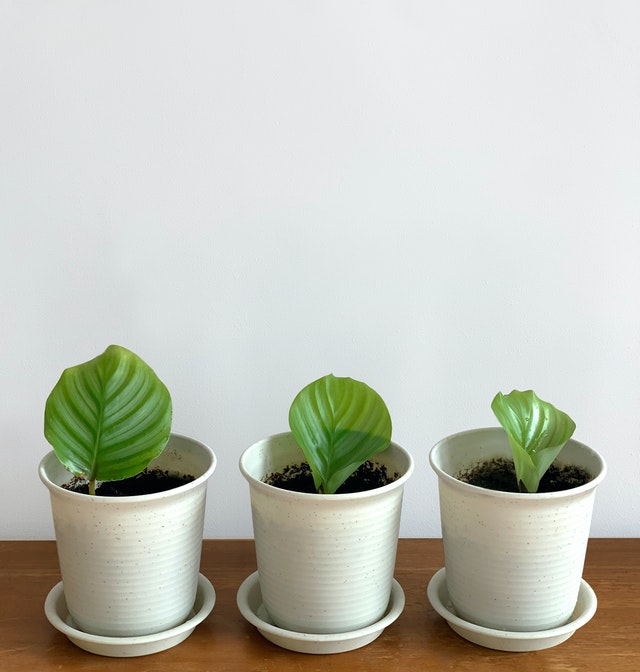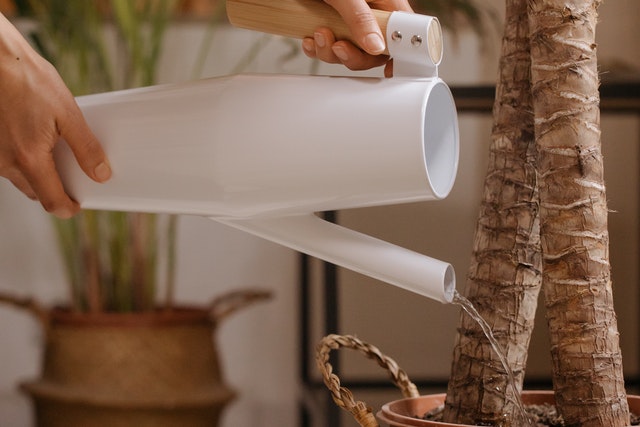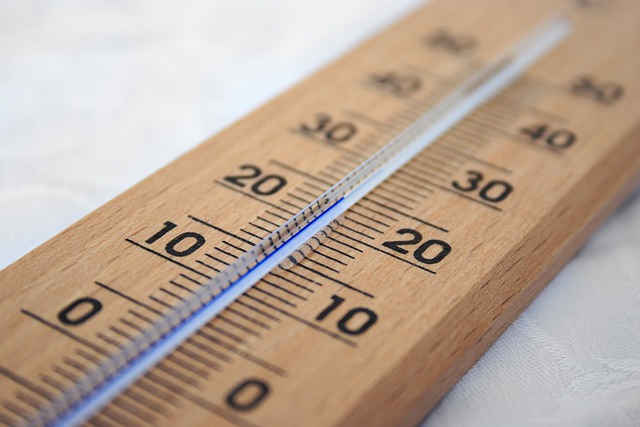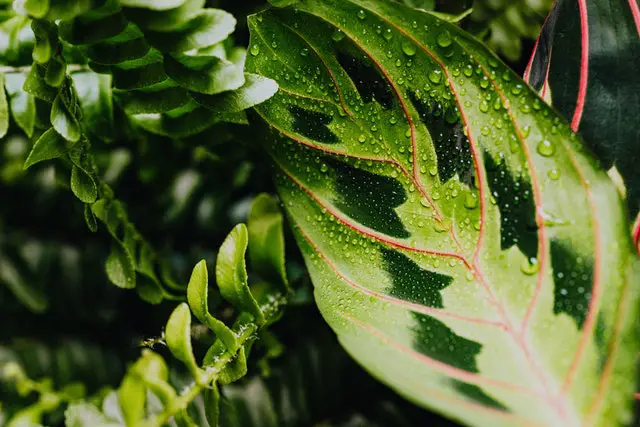If you’ve noticed your calathea leaves pointing up, you might wonder why. If you’re new to keeping calatheas, you might worry there’s something wrong with your plant. I can reassure you there’s usually nothing to worry about if you see your calathea’s leaves folding and pointing up. Your Calathea leaves may be pointing up for a number of reasons.
Calathea leaves fold up at night as part of their photosynthesis process. This helps them maintain their energy and moisture during nighttime.
Your calathea needs attentive care, and might be suffering from something else if their leaves don’t fold up. I’ll explain reasons why this might be the case, and tell you what to look out for.
Why Are My Calathea Leaves Pointing Up?

If you’ve noticed your calathea’s leaves folding and pointing up during the night, don’t worry. This is a sign of a natural phenomenon called nyctinasty. It happens across all types of calathea.
Calathea plants naturally grow at the bases of rainforest trees in Brazil. This is a low-light environment, and the calatheas have to take as much advantage of daylight as possible. This is why they stand at full attention with open leaves during the day. It helps them properly photosynthesize.
In turn, folding up their leaves during the night helps the calathea preserve its energy for the next day. The process also preserves the moisture they collect from their surrounding area.
Calathea plants have an organ called the pulvinus slightly below their leaf bases. Cells in the pulvinus lengthen in lower light, which causes tension between the leaf blade and its stalk. The leaf then folds up. This often looks like hands folded in prayer. You may have heard the name “prayer plants” when learning about calathea.
If your calathea follows this day to night cycle, that’s great! It means you’ve replicated their natural light cycle. You’ve also probably given them the right amount of water and humidity.
If your calathea has folding or curling leaves during the day, there may be a problem. If it doesn’t close its leaves during the night, it might be under some stress. Here are some reasons why your calathea might not be behaving normally.
1. Your Calathea Is Exposed to too Much Light
If your plant isn’t closing up its leaves at night, the most likely reason is too much light exposure. Here are some useful solutions:
- Add a sheer curtain to your calathea’s preferred window
- Move your calathea to a shadier part of your house (this also prevents potential sunburn and heat stress)
- Place your calathea under growth lights during the day, turning them off at night
2. Your Calathea Isn’t Getting the Right Amount of Water

This is a common beginner mistake with calathea plants. You could potentially be watering them too much, or not enough.
A calathea is a tropical plant, and needs plenty of water to thrive. Giving them too little water causes the leaves to wilt, droop, and curl up at the edges. This is something houseplants often do to conserve water.
On the other hand, you might be overdoing it. Overwatering a calathea can cause a condition called root rot. If your calathea has root rot, you’ll see yellowing leaves and dry brown leaf tips and spots. You might also notice a funky smell in the soil.
3. Your Calathea Has an Infestation
Lots of pests love calathea plants. Among the repeat offenders are spider mites, aphids, and mealybugs. These insects can cause deformities in your plant, which might prevent it from folding its leaves properly at night.
Inspect your calathea for insects and their eggs. Treat your plant with a soap spray to kill any insects and eggs. Hopefully, you’ll prevent any insects from hatching and continuing the infestation.
4. Your Calathea is in a Dry Environment
Since the Brazilian rainforest is a humid environment, you’ll want to keep your calatheas at a high humidity. Without it, your plant might not be able to absorb enough moisture to close their leaves. You can use a hygrometer to check the humidity in your home.
There are a few ways you can keep your calathea in a humid space. The first is to put a tray with pebbles underneath the pot. This will create humidity through evaporating water. You can also use a plant humidifier, especially in dryer months. Misting your calathea regularly can also help with humidity levels.
5. Your Calathea is Under Temperature Stress

Temperature stress happens when a calathea is either too hot or too cold. The perfect temperature for a calathea plant is between 65 and 90 degrees Fahrenheit (about 16-32 degrees Celsius). In improper temperature conditions, a calathea might not be able to close its leaves properly.
Take care to monitor the temperature around your calathea. Keep the plant away from direct heat sources in your home. You can also set up a fan to circulate cool air around the space. Monitor your plant during heat waves and cold snaps to make sure it’s feeling ok.
6. Incorrect Fertilizer Application
Not using the right amount of fertilizer can cause your calathea leaves to point up. In other words, excessive or too little fertilizer use can do more harm to the plant than good.
Apart from causing the plant’s leaves to point upwards, overfertilizing your calathea can cause leaf discoloration. If you accidentally add excess fertilizer to the plant, use enough water to rinse it off. In addition, add a moderate amount of fertilizer to the calathea if it’s not getting enough nutrients. But most importantly, follow the instructions on the fertilizer package.
7. Chemical Reaction
Another common factor that can cause your calathea leaves to look up is the reaction to chemicals. One of the most common ways this problem happens is through watering. If you water your calathea regularly with tap water, the plant will suffer.
This is as a result of the mineral content in the water, which the plant cannot tolerate. Not only will the calathea begin to point up, but its leaves may begin to fade and droop over time.
Perhaps you notice mineral buildup on the calathea soil surface; don’t panic. Consider using distilled or rainwater for the plant. When watering the calathea, the key is to provide a moderate amount.
Also see: Sunburnt Fiddle Leaf Fig
Outro
So why are calathea leaves pointing up? If they’re happy and healthy, they’re folding and pointing up at night as part of their normal photosynthesis process. In fact, if they’re not folding up, it might be a sign that something is wrong with them.
There are various reasons why they might not fold up, including temperature stress, the wrong amount of water, too much light, bugs, and low humidity. On the other hand, they might fold or curl up during the day due to underwatering or overwatering.
Frequently Asked Questions
How Do I Know if My Calathea is Happy?
A happy calathea has no brown or dry spots on their leaves. Their leaves naturally close up at night and then open fully during the day. You might even see them move during the day to catch the sun. You’ll see strong and sturdy leaves and stems, not drooping ones.
Also look for where the roots are in the pot. If they’re all in the soil and not sticking out, that’s a sign your calathea is happy and healthy.
Why are My Calathea Leaves Curling Up?
Here are three potential reasons why your calathea leaves are curling up:
– the wrong amount of water–either too much or too little
– the temperatures are too high
– bugs
What Does an Overwatered Calathea Look Like?
If you think you’ve overwatered your calathea, check the leaves first. An overwatered calathea has yellowish leaves. While the yellow leaves start around the bottom of the plant, they can reach the top if the overwatering gets really bad. If the leaves are curling and wilting, it may be a sign your plant is trying to conserve water.
The leaves might also have brown leaf tips, which are a sign of root rot. Another sign of root rot in a calathea is gross-smelling soil.
Here are some tips to help an overwatered calathea:
– move it into a smaller pot–a pot that’s too big for a calathea means the soil takes longer to dry out
– make sure the plant pot has plenty of drainage holes
– give your calathea more light: a calathea in low light won’t grow as large, meaning it doesn’t need as much water

Hey, I’m Lisa and I’ve been an avid gardener for over 30 years. I love writing, talking and living in the garden! Feel free to connect with me on my socials below

